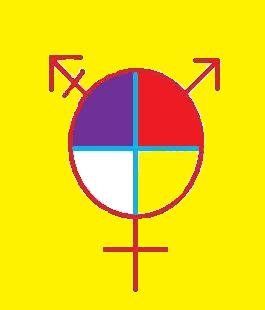
|

|

|

|

|
Joan Dark's Transsister Circle | 
|
|
About Gatekeeping and the Pathologization of Trans Identity |
| by Joan Dark |

|
Overview
In 1966, Johns Hopkins University in Baltimore, Maryland announced its program for sexual reassignment surgery. This was the first American university to have such a program. This precedent effectively made sex reassignment surgery (SRS) a respectable sector of the American medical community. Later the same year, the University of Minnesota began its own program, publicly announcing it inauguration in December. In 1967, Northwestern University Medical School, north of Chicago, established its study and treatment center. In 1968, Stanford University at Palo Alto, California began its Gender Reorientation Program, later renamed the Gender Identity Clinic. Soon after, the University of Washington at Seattle, opened its Gender Identity Research and Treatment Clinic.
The institutions navigated a course between the critics who were against transsexual surgery and what was perceived as excessive demand by those seeking such surgery. At the end of the 1960's, there was a capacity to treat only a small percentage of the hundreds of individuals requesting treatment. There was also a chance of lawsuits from patients who had undergone e treatment but became dissatisfied with the consequences.
By the end of the 1960's, systems were developed for selecting small, numbers of patients from the hundreds of applicants for sex reassignment surgery. Ideally, such a system only rejected those who would have otherwise come to the conclusion at some time after the irreversible surgery that they had been better off before the surgery. But the subjective judgments of the medical providers were apt to be influenced by personal and cultural biases. Frequently, this was the case. For example, those male-to-female transsexuals who would obviously be quite sexually attractive after hormone treatment and surgery often had a significantly better chance of being chosen than those who would not. Each institution had its own particular system, but they had points similar in intent and nature. Doctors who utilize such systems were,and still are, sometimes referred to as "gatekeepers."
For sex reassignment surgery from the late 1960's until the early 1980's, typical requirements on the part of the patients included:1
Psychological evaluation to determine if the patient had longstanding crossgender identification and no severe mental illness.
Intelligence enough to understand what the surgery could and could not do for them.
A total willingness to take hormones and live for a certain minimum number of months or years as a member of the "other sex" before undergoing irreversible surgery. This often includes the requirement that, during the latter part or all of this period the transsexual could "pass"in public as a member of the "other sex." This means that the transsexual must be able, after some period time, to mingle with the general public without anyone "spotting" (i.e., recognizing) the true birth sex of the transsexual. The aim generally was to choose candidates for surgery who would, after hormone treatment and surgery, be able to pass as a member of the "other sex" while applying for a job and be able to perform the job day-to-day among co-workers without being spotted. Of course, a change of name would generally be needed to achieve this.
True memory of having had, from very early age, conscious thoughts and feeings about "being born in the wrong body."
Extreme social difficulty living as being of one's assigned birth gender in all facets of life.
The absence of any attraction to the opposite sex. (If the patient is a transwoman (male to female), she must not be innately attracted to any women; it the patient is a transman (female to male), he must not be innately be attracted to any man. (The purpose of this requirement was to avoid producing any gay men or lesbians.)
If married, A total willingness to divorce one's spouse. (The surgery would not be performed until after the divorce.)
In 1979, the Harry Bejamin International Gender Dysphoria Association was organized to promote ethically and scientifically correct standards of psycho-medical care for transsexuals. In particular, the association advocates a set of standards that they give in their publication, "The Harry Benjamin International Gender Dysphoria Association's Standards of Care for Gender Identity Disorders" (SOC). The Benjamin standards are now used by most of the respected institutions today involved with hormone treatment and surgeries specifically for transsexuals. Of course, these standards are subject to interpretation by each institution and by individuals within each institution. The latest version of the SOC available on the web seems to be the "Sixth Version 2001." Fortunately, there are no longer any requirements regarding sexual orientation or marital status.
Seperating the Transsexuals from the Transvestites
One major problem with gatekeeping systems for transsexuals seeking sexual reassignment surgery lies in the quality or nature of the psychological evaluations that was deemed an essential part of these formalized systems. The psychological evaluations often incorporate flawed psychological theories. The theories are allegedly based on objective scientific findings but often they are loaded with the subjective interpretations of prejudiced psychologists and psychiatrists. A good example is the way in which many psychologists differentiated between "transvestites" and "true transsexuals."
In 1966, Harry Benjamin asserted in his groundbreaking book, The Transsexual Phenomenon: "a sharp and scientific separation of the two syndromes [i.e. separation between transvestism and transsexuality] is not possible...We have as yet no objective diagnostic methods at our disposal to differentiate between the two."1 But there were a great number of psychologists and psychiatrists who did believe that they understood both the psychology of "transvestism" and of transsexuality that they could clearly determine whether a cross-dresser was a true transsexual or a transvestite.
The term transvestite is generally defined as a heterosexual male who has a primarily male gender identity and cross-dress for erotic reasons.2 Then true transvestism is regarded as being a fetishism which may be called "transvestic fetishism." "Transvestic fetishism is the erotic experience of cross-dressing behavior."3
The current standard diagnostic manual of the American professional mental health community (as of March 2010), the DSM-IV-TR, states that transvestic fetishism "has been described only in heterosexual males."4
During the late 1960's and most of the 1970's, if not beyond that period, it was perceived by gatekeepers that "Transvestites requesting sex changes were a headache."5 For some gatekeepers, "a single episode of cross-dressing in association with sexual arousal was regarded as sufficient to exclude the diagnosis of transsexualism."6
Harry Benjamin had quite a different perspective. In his work The Transsexual Phenomenon, he revealed his own model in which there are six types or syndromes of gender variance represented on a transvestite-transsexual continuum. "This was the first clear delineation of the differences between transvestites and transsexuals, a model that has remained the blueprint of the medical model today. The continuum describes gender-aggressive behavior by the persistence or intensity of cross-dressing behavior and the desire to change one's physiology."7
Some Relevant Excerpts
From Reid Vanderburgh, Transition and Beyond (2007):
| "I am a member of WPATH (World Professional Association for Transgender Helath, formerly HBIGDA, the Harry Benjamin International Gender Dysphoria Association.) I joined HBIGDA in 2001, shortly after receiving my master's degree. I did so because I wanted to influence future iterations of the Harry Benjamin Standards of Care (SOC). Having written my master's thesis on the transformation process, I had done enough research into the history of transition in this country to have a profound respect for those professionals who took a public stand (often unpopular) on behalf of helping people transition physically. However, as someone who has undergone physical transition, I have also come to realize how poorly the medical model fits the process, and the medical model is the paradigm underlying the SOC." | ||
|
- Reid Vanderburgh, Transition and Beyond: Observations on Identity Disorder (c. 2007), pp. 57-58. |
||
| "At some point, gender identity disorder (GID) will be removed from the DSM, a move that is long overdue. If GID is not a psychological disorder at all, but a reflection of gender identity not matching bodily sex, then it has no place in a book whose purpose is to describe psychological problems. | ||
| "I would hope that removal of GID from from the DSM will soften the resistance many trans people feel toward seeking out therapy when their transition process throws them a curveball. If GID is not in the DSM, it is less likely that newly-trained therapists will try to make trans identity an automatic pathology. The removal of homosexuality from the DSM in the early 1970's resulted in precisely this sort of shift, away from pathologizing sexual orientation and toward a model of helping people accept themselves, deal with homophobic attitudes within their families, etc. While there are still conservative therapists who attempt to 'cure' homosexuality, this is not the mainstream standard within the profession, nor is it considered ethical treatment. Within my profession, sexual orientation is now viewed as a fixed identity, not as an issue of behavior. I believe that over time, the same will be true when discussing gender identity." | ||
| - Reid Vanderburgh, op. cit., p. 62. | ||
| "Gender is not an issue of psychological pathology, and the client is the only one who can make decisions about their core identity. It is not up to the therapist to determine whether or not the client is trans, any more than it is up to the therapist to determine what the client's sexual orientation is." | ||
| - Reid Vanderburgh, op. cit., p. 18 | ||
From Arlene Istar Lev, Transgender Emergence (2004), pp. 188-91:
|
"The voice on the phone is halting and measured when I return the phone call requesting an appointment. 'I can't believe I'm actually calling you. I need to talk with someone. I'm very afraid. I've never told anyone before, but I need to talk about gender issues. "One does not need to be a competent and skilled clinician to determine that the person who left this message is in deep emotional pain. Potential clients often leave repeated messages like this, sometimes for years on end, with no callback number. When clients attend therapy, they are often frightened and exhibit many apparent symptoms of mental disturbance, including anxiety, panic attacks, obsessive-compulsive disorder, depression, manic episodes, impulsive behavior, eating disturbances, sleep disorders, sexual paraphilias, as well as marital problems, histories of childhood trauma, and chronic unemployment. The list of mental health disturbances that gender-variant people are thought to suffer is exhaustive. Almost all writers discuss this population in terms of 'illness,' 'pathology,' disorder,' 'condition,' and 'problem' and identify clients as demanding, manipulative, controlling, coercive, and paranoid. Gender-variant people are identified as impulsive, depressed, isolated, withdrawn, anxious, thought-disordered, and suffering from narcisstic, schizoid, and border-line personality features. They are perceived as immature and egocentric with profound dependency conflicts, although natal males are almost always seen as more disturbede than natal females (with the exception of Lothstein, 1983 [Fewmale to Male Transsexualism: Historical, Clinical, and Theoretical Issues, Boston: Routledge and Kegan Paul, 1983.] who views females as equally disturbed). This is true in almost any article or book that addresses the clinical needs of this population, including those written by supportive clinicians who have committed their lives to advocating for the therapeutic and medical treatments that enable transsexuals to live in their chosen gender expression. A few examples will suffice." |
||
| [Two relatively long paragraphs giving examples follow the above paragraph. We skip over them here.] | ||
| "Certainly, these expert clinicians are skilled at diagnoses and able to accurately identify psychopathological conditions. The need for diagnostic assessment and differential diagnosis is paramount, for gender identity disturbances can mask more serious mental health problems or may be a less significaant part of a pervasive psychopathology... | ||
| "The difficulty lies not in professional assessment processes or diagnostic competency, but rather in the perspective that assumes psychopathology in all gender-variant people without understanding the context for their difficulties. When Evelyn Hooker studied the first nonclinical sample of homosexual men in 1969, she discovered that this population did not exhibit there mental issues that had been attributed to them in previous studies of clinical samples of homosexuals (D'Emilio, 1983 [D'Emilio, Sexual Politics, Sexual Communities: The Making of the Homosexual Minority in the United States, 1940-1970, Chicago: Chicago University Press, 1983]). Similarly, most studies of transsexual and gender-variant people are composed of those who seek services from clinicians, the very people who are most likely to be experiencing distonia and disphoria, and those most desperate for services. However, unlike homosexual men, transgendered and transsexual people who desire body modifications must seek out services to live authentically and, paradoxically, the very criteria which makes them eligible for these services also determine that they must have mental health issues. For example, the need to prove that one is transsexual has historically depended on one's distress in his or her body and hatred of his or her genitals to the point of expressing suicidality and self-harm behaviors. These same behaviors lead clinicians to label such clients as borderline, obsessive, depressed, and impulsive. | ||
| "That some gender-variant people exhibit these symptoms is indisputable; however, it is necessary to make a clinical distinction between mental disorders that are independent of gender issues and those that are the symptoms and sequelae of living with daily social denigration. Ego-dystonic homosexuality was removed from the DSM when it became evident that most homosexuals struggled with their identity due to the homophobia of the social world, not because of an intrinsic psychological disturbance. Similarly, most gender-variant people suffer from deep internal struggles with their gendered and sexual selves given the societal nature of transphobia and the internal conflicts that develop trying to live contrary to their natures in a dimorphic culture. Sadly, the clinical community has often reinforced these struggles, rather than alleviate them. Wilson (1997) [Wilson, K., 'Gender as Illness: Issues of Psychiatric Clarification,' Sixth Annual International Conference on Transgender Law and Employment Policy (ICTLEP), Houston, Texas.] said, 'The psychiatric community interpretations of inherent transgender pathology serves to attribute the consequences of prejudice tro its victims, neglecting the true causes of distress' (p. 10, italics mine), i.e., the daily assaults on the human dignity of transgendered people has been rarely acknowledged and even less frequently addressed with few researchers even mentioning its influence." | ||
| - Arlene Istar Lev, Transgender Emergence: Therapeutic Guidelines for Working with Gender-Variant People and Their Families (c. 2004), pp. 188-91. | ||
BIBLIOGRAPHY
Books
Lev, Arlene Istar. Transgender Emergence: Therapeutic Guidelines for Working with Gender-Variant People and Their Families. Binghamtom, New York: The Hawthorne Clinical Practice Press, 2004. 467 pages. Paperback, ISBN-10: 0-7890-2117-X, ISBN-13: 978-0-7890-2117-5.
Meyerowitz, Joanne. How Sex Changed: A History of Transsexuality in the United States Cambridge, Massachusetts: Harvard University Press, 2002. 363 pages. Paperback, ISBN-10: 0-674-01379-4; Hardback, ISBN-10: 0-674-00925-8.
Vanderburgh, Reid. Transition and Beyond: Observations on Gender Identity. Portland, Oregon: Q Press, 2007. 289 pages. Paperback, ISBN-10 1-893075-38-9.
Internal Links
On the Web
Gender Identity Disorder (GID) Reform Advocates--Because Our Identities are Not Disordered.
Translife.net - "Transgender 101 - Harry Benjamin Standards of Care"
TSRoadMap.com - "Transsexual Road Map - a travel guide to set priorities and choose your route."
FOOTNOTES
1The list given is compiled from these three sources: Meyerowitz, Joanne, How Sex Changed: A History of Transsexuality in the United States (2002), pp. 224-25; Stryker, Susan. Transgender History (2008), p. 112; Vanderburgh, Reid, Transition and Beyond: Observations on Gender Identity (2007), pp 38-39.
2Benjamin, Harry, The Transsexual Phenomenon, New York: Julian Press (1966), p. 35. Quoted in Lev, Arlene Istar, Transgender Emergence: Therapeutic Guidelines for Working with Gender-Variant People and Their Families, Binghamtom, New York: The Hawthorne Clinical Practice Press (2004), p. 134.
3Lev, Arlene Istar. Transgender Emergence: Therapeutic Guidelines for Working with Gender-Variant People and Their Families. Binghamtom, New York: The Hawthorne Clinical Practice Press (2004), p. 133.
4Ibid., p. 170.
5Diagnostic and Statistical Manual of Medical Disorders, Fourth Edition, Text Revision (DSM-IV-TR), American Psychiatric Association (2000), p. 574.
6King, D. The Transvestite and the Transsexual: Public Categories and Private Identities, Brookfield, Vermont: Avebury/Ashgate (1993), p. 53. Quoted in Lev, op. cit., p. 134.
7Baker quoted in Burich, N. and McConaghy, N. "Can Fetishism Occur in Transvestism?", Archives of Sexual Behavior 6 (3), p. 224. Quoted in Lev, op. cit., p. 134.
8Lev, op. cit., p. 133.